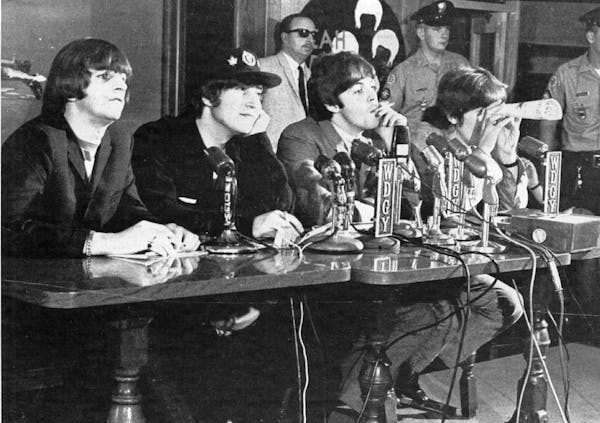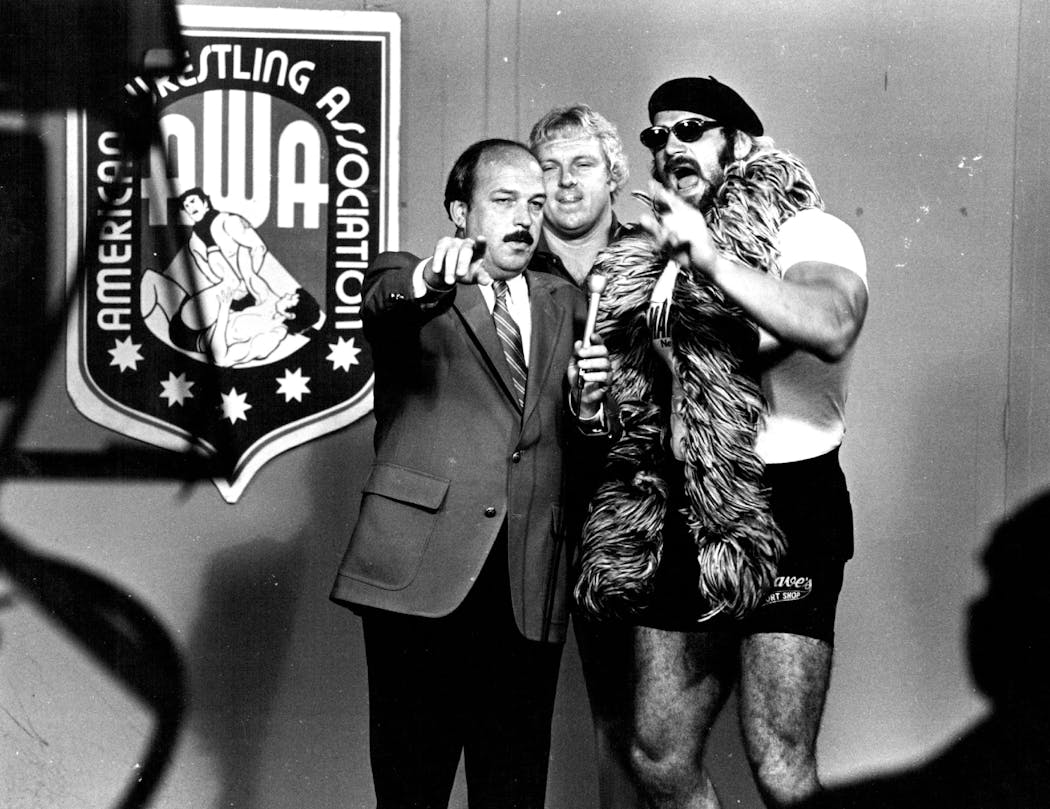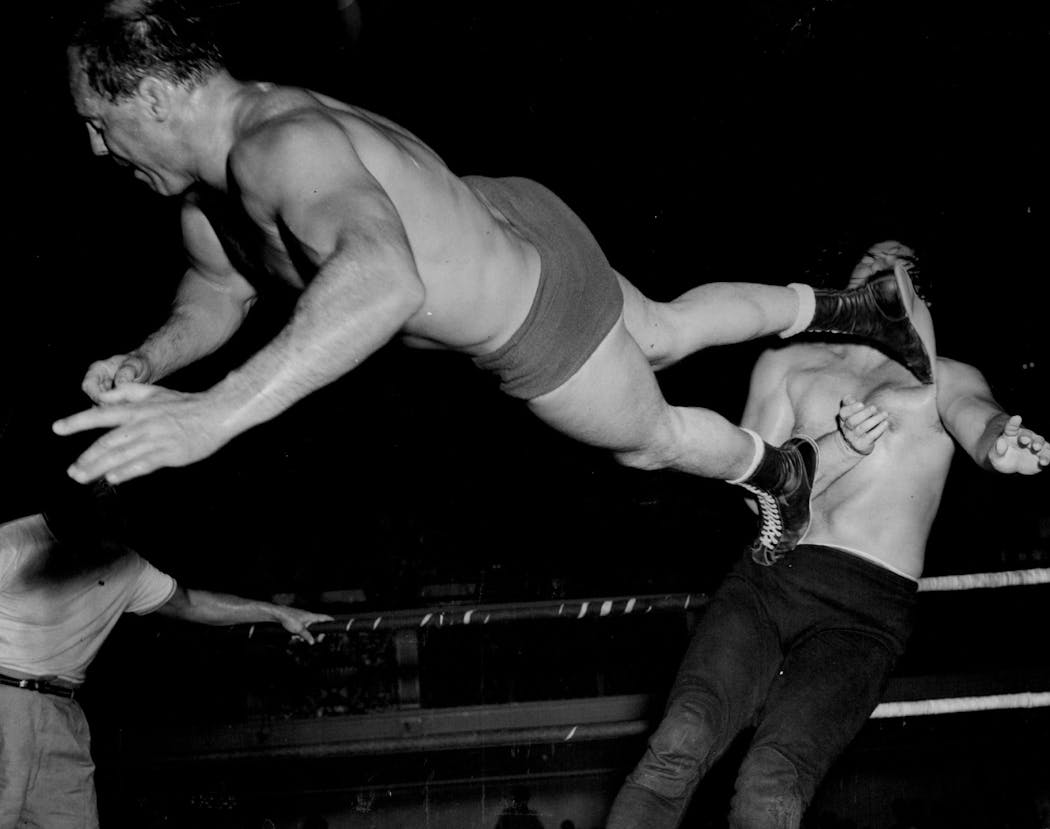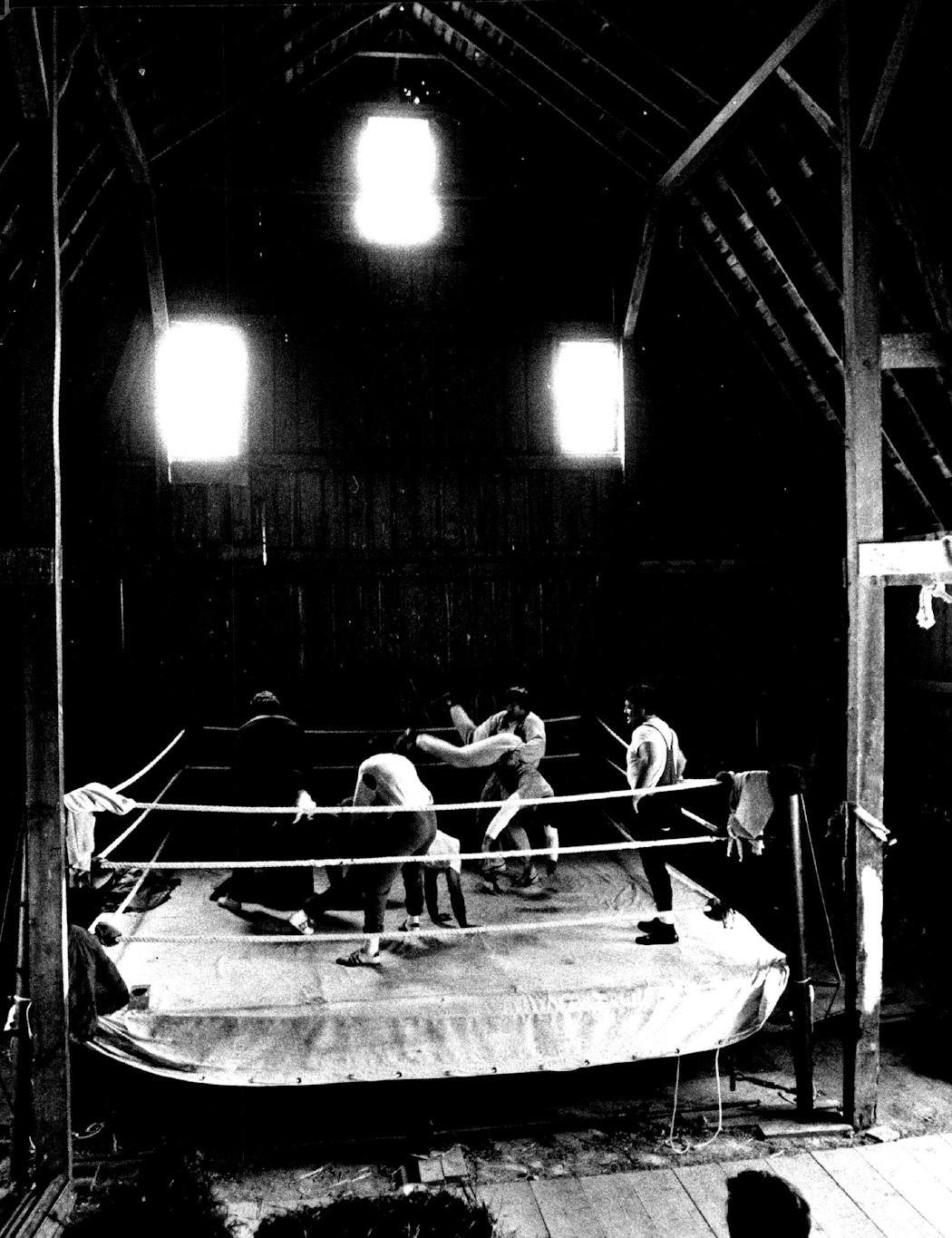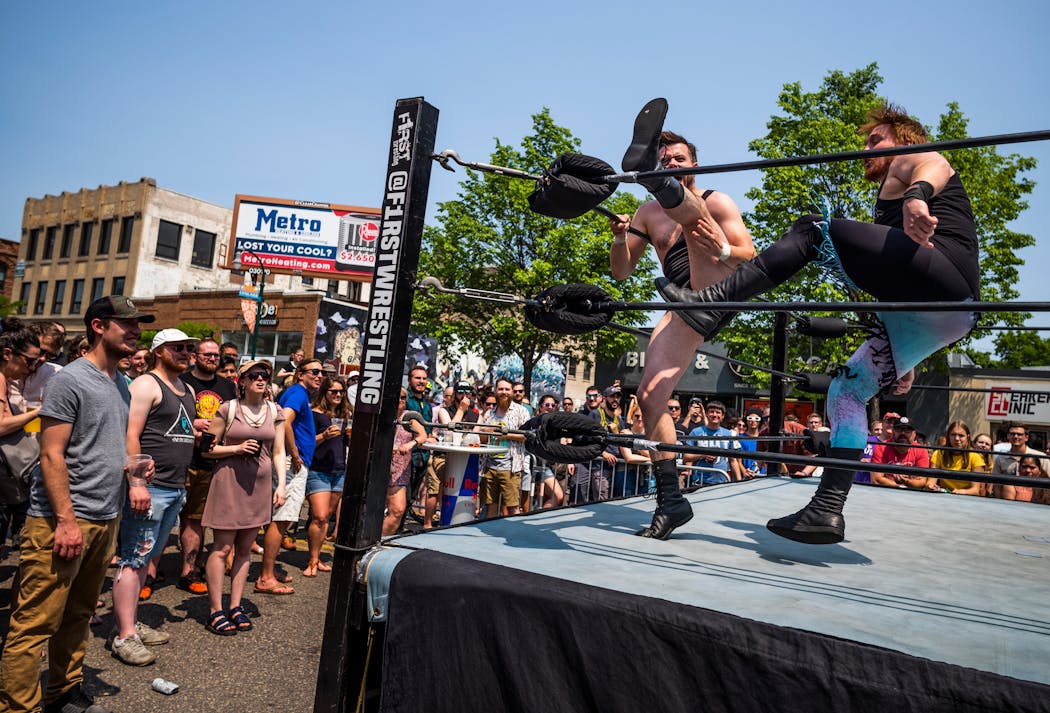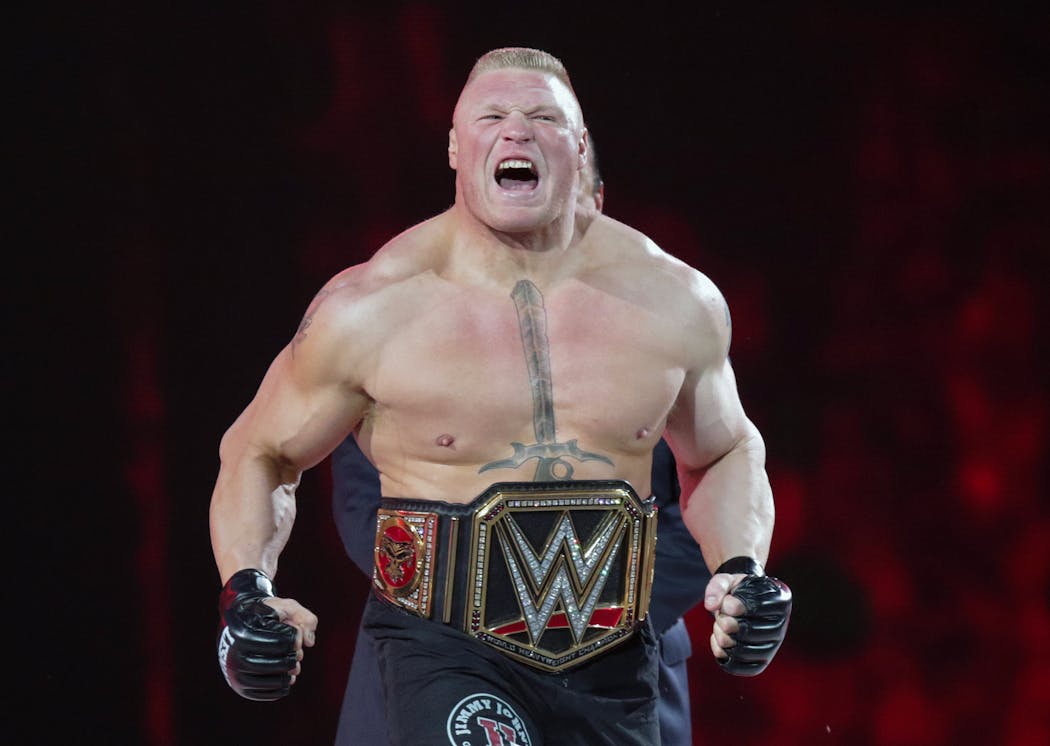Why is Minnesota such a hotbed of professional wrestling?
Listen and subscribe to our podcast: Via Apple Podcasts | Spotify | Stitcher
On any given night — on television, in arenas or even at breweries — raucous pro wrestling fans watch as musclebound men and women send each other through tables or face-first into the mat to settle feuds befitting a soap opera.
Reader Casey Carmody, of St. Paul, grew up watching this unique sport, which features predetermined outcomes and storylines but also physical feats and risks that cannot be faked. He's long enjoyed consuming documentaries and podcasts about the history of pro-wrestling — or, as his friends like to rib him, "watching shows of old guys talking about wrestling."
So when he recently learned that World Wrestling Entertainment (WWE) might be considering Minneapolis to host its annual Wrestlemania extravaganza in the future, Carmody started thinking more about Minnesota's outsized contribution to the sport. He sought answers from Curious Minnesota, the Star Tribune's reader-powered reporting project, about how Minnesota became a hotbed of pro-wrestling.
"Some of my favorite wrestlers as kid were 'Mr. Perfect' Curt Hennig and 'Ravishing' Rick Rude," Carmody said. "And I really liked them even more knowing that they were from Minnesota."
Before professional wrestling exploded into a multibillion-dollar global phenomenon, Minneapolis was among the most influential "hubs" for what was then more of a regional enterprise. Minnesotans helped develop the sport, which pits heroes and villains against one another in contests that can resemble Greco-Roman grappling, barroom brawling, gymnastics — or all of the above.
Weekly wrestling shows from Minneapolis regularly drew some of the top ratings on network television here from the 1960s through 1980s. Scores of legendary competitors and on-air personalities got their start in Minnesota — including the state's 38th governor, Jesse "The Body" Ventura.
But why here?
"Part of it is tradition," said Ken Anderson, an ex-WWE star who now trains the next generation of aspiring pro wrestlers at The Academy wrestling school in Minneapolis. "It's just that people grew up watching and they pass that down to their kids and they pass that down to their kids and so forth."
The wrestling pioneer
The story starts with Verne Gagne, a collegiate football and wrestling star from the University of Minnesota in the 1940s.
Gagne picked a career as a professional wrestler over a chance to play football for the Chicago Bears. His in-ring persona was an extension of his collegiate wrestling background, as he preferred to emphasize his no-nonsense, technical wrestling prowess.
Gagne's profile soared on the Chicago-based DuMont Television Network's nationally broadcast shows. After about a decade of wrestling, Gagne and promoter Wally Karbo bought the Minneapolis Boxing and Wrestling Club and later broke away from the National Wrestling Alliance, the governing body for a series of regional wrestling promotions around the country.
The two rechristened their organization the American Wrestling Association (AWA), which reigned for three decades as one of the preeminent wrestling "territories" in the nation. It is credited with helping pioneer today's modern industry.
The AWA's weekly televised "All-Star Wrestling" shows aired on all of the major networks in the Twin Cities as Minneapolis grew into one of the nation's top regional hubs for the sport.
Gagne, who died in 2015 at 89, wasn't just an owner and promoter of AWA. He also won its top championship as an in-ring performer numerous times between 1960 and 1981. Gagne was one of the premier heroes ("babyfaces") for the promotion, conquering villains ("heels") such as Mad Dog Vachon and Baron Von Raschke.
Gagne's wrestling empire included a wrestling school inside a barn on his farm near Lake Riley in Eden Prairie. His influence carried on through the nearly 150 eventual stars who emerged from the school's grueling curriculum.
Ric Flair, considered among the most accomplished and skilled pro wrestlers of all time, was a Gagne student. So was Gagne's son Greg Gagne (no relation to the baseball player), the Iron Sheik, Ricky Steamboat and Carmody's childhood favorites, Rude and Hennig. Ventura also starred in the AWA, as did legendary announcer Mean Gene Okerlund.
"Had they not come into the business the whole scope of the business would have looked a lot different," said local pro wrestling historian George Schire, of those trained and tutored by Gagne and his peers in Minnesota.
Even Hulk Hogan's path to crossover superstardom included a two-year stint in the AWA in the early 1980s, during which he became a fan favorite. But Vince McMahon poached Hogan to be the top star of his own World Wrestling Federation — now the WWE — just as he entered his prime.
McMahon is blamed for killing off the territories in the 1980s and early 1990s. He lured top stars away from their respective promotions and paid television stations and local venues not to host his competition's programs, Schire said. Gagne's AWA closed up shop in 1991.
The AWA's long legacy
Minneapolis' place as a top regional center for pro wrestling ensured that fans and would-be wrestlers here were knowledgeable and passionate about the sport for years to come, said Jeff Jarrett, a third-generation pro wrestler and promoter who began his career in the mid-1980s.
"Whether it was Charlotte or Tampa or Memphis, or Dallas, Los Angeles, Portland and Minneapolis, those hubs were the major crossroads in professional wrestling," said Jarrett, who still wrestles and is also the director of business development at All Elite Wrestling (AEW), the second-biggest wrestling promotion today behind WWE.
Among AWA's devoted weekly watchers was Arik Cannon, who grew up in Minneapolis watching AWA characters on Saturday mornings at his grandmother's home.
"For me, as a kid, it was pro wrestling and then everything else," Cannon said. "Wrestling was my priority number one."
Cannon turned that childhood love for professional wrestling into a career in the early 2000s. By 2006, he was competing for Wrestling Society X, a short-lived promotion that aired on MTV.
He used his money earned from that stint to found F1RST Wrestling in Minneapolis a year later. Its annual "Wrestlepalooza" showcase, which started in 2013, now regularly sells out First Avenue's main room with its blend of colorful wrestling performances and live music acts interspersed between matches.
F1RST Wrestling helped provide a platform for wrestlers such as Seth Rollins — then known as Tyler Black — to hone their craft before going on to become the WWE's champion.
Cannon revived a piece of Minnesota wrestling lore last year when, under his promotion's umbrella, he staged a show at the Mall of America. It was there in 1995 when the now-defunct World Championship Wrestling debuted its Monday Nitro weekly television show that sparked a yearslong war with WWE.
"I have goosebumps just talking about it because that's how cool it was," Cannon said.
The promotion is returning to the mall in September.
Steel Domain Wrestling and Midwest All-Star Wrestling are also keeping independent pro wrestling alive in the state.
Ed Hellier, another diehard AWA fan growing up, founded Steel Domain in 1998 in West St. Paul. Among its early acts was CM Punk, who went on to have one of the longest reigns as champion in WWE and, at 44, is now among the top stars for AEW.
"I still think it is vibrant," Hellier said of Minnesota's passion for wrestling. "I don't see it dying off."
The next wave
Anderson, the WWE wrestler-turned-trainer, spent the early days of his career wrestling in American Legion halls for Hellier's promotion. He now runs The Academy wrestling school in Minneapolis, which opened in 2016. The school is already starting to produce its own wave of next-generation wrestlers.
Gable Steveson, a University of Minnesota national wrestling champion, has also reached out to Anderson's school for training ahead of his own professional debut since being signed to a deal by WWE.
Steveson would be following in the footsteps of fellow Gopher alum Brock Lesnar, a multi-time world champion for WWE and former Ultimate Fighting Championship heavyweight titleholder whose net worth is estimated at $25 million.
Curt Hennig and Brad Rheingans — two Gagne pupils — helped train Lesnar as he entered the business. And like Gagne before him and Steveson after, Lesnar won a national collegiate wrestling championship before making his pro debut in 2000.
Lesnar still appears as a special attraction at major WWE events. When he walks out to the ring, the crowd erupts upon hearing the opening chords of his entrance music and the ensuing pyrotechnics.
The ring announcer then bellows: "From Minneapolis, Minnesota!"
If you'd like to submit a Curious Minnesota question, fill out the form below:
Read more Curious Minnesota stories:
Why are all of Minnesota's pro teams named after the state, not a city?
How did pro baseball get its start in Minnesota?
Why can't you buy a car on Sundays in Minnesota?
Why was the Mall of America built in Minnesota?
Are roundabouts really safer than traditional intersections?
Why do so many Twin Cities mall names end in "dale"?
